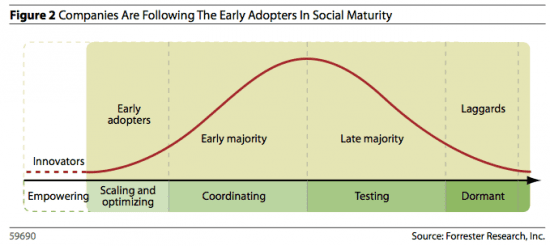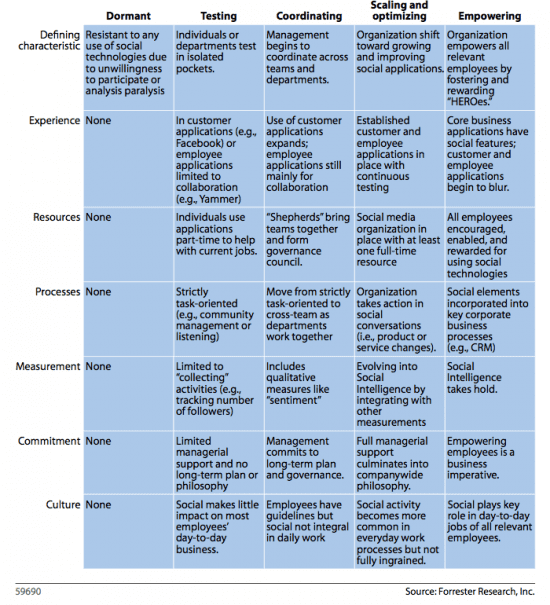Are you dormant, testing, co-ordinating, optimizing or empowering?
On Smart Insights, Paul Fennemore recently recommended his social media adoption framework which was popular, so I thought I'd alert you to a new approach to review social media maturity. Forrester have released a report that offers a social maturity model to help illustrate the common stages of change that occur as marketers optimize their social activities from dormant to empowered workforce.
Where are you on the 5 stages of social maturity?
Customers and employees are becoming increasingly empowered by social technologies, dramatically changing the way they communicate and collaborate. We know now this isn't a fad - it's a fundamental shift. To succeed in this new world, companies must make fundamental changes to resources, skills, tools, processes, and culture. Forrester calls this process of change 'social maturity', and it consists of five stages:
- Dormant
- Testing
- Coordinating
- Scaling and optimising
- Empowering the workforce

It's probably fair to say we see most brands in stages (2) and (3)?
Forrester suggest that to help accelerate your company’s social maturity journey, marketers should act as shepherds — coordinating across functions and demonstrating to senior executives the benefits of social tools.
The 6 key criteria of social maturity
A key component of the empowered organisation is use of social technologies to transform a company’s communication and collaboration.
While tools such as 'social sign-on' enabled websites are important in the early stages, social maturity represents a fundamental shift in your company’s organizational and cultural mores.
Forrester has identified six key criteria to support growth
- Experience: this is not just implementing technologies; it is also documenting and sharing learning across the organization
- Resources: Employees’ skills and responsibilities need to change along with the organisation. Relevant employees are empowered to use social tools to do their jobs
- Process: Have a planned workflow for how to manage the tools. How to manage a community, listen to the social and incorporate social technologies into existing business processes; 1) task-oriented; 2) cross-functional collaboration and 3) business process change
- Measurement: Including basic data collection, the use of quantitative and qualitative measures, and the move toward Social Intelligence with the ability to tie it back to business objectives
- Commitment: Commit management create a company-wide vision and develop a long-term plan to empower employees and customers
- Culture: Senior management sets the social priorities as more employees buy into the benefits of using social technologies to do their work

Steps on the path to social maturity
Because of the nature of digital marketing management — working at the crossroad of marketing and IT — Forrester suggests that marketers need to embrace the cross-functional opportunity and take the following steps to help the path to social maturity:
- Social media is not a channel. Social media should not be a line item on a marketing or media plan. Teating social technologies as one aggregate channel will hinder your social maturity. Instead, look for opportunities to create social engagement in all your current marketing initiatives.
- Involve IT people. Many marketers still avoid involving IT because social technologies are often easy to set-up, being web-based. Yet IT brings important experiences to the table, like knowing how to integrate new technologies into the company infrastructure, how to protect against security breaches and how to deal with mistakes.
- Encourage the use of employee collaboration tools. With their familiarity with social tools, marketing teams are the perfect people to test employee collaboration tools. Places to start in your team’s everyday business processes include: idea development, campaign management and team communication; and then begin to invite other teams to participate.








